How To Make Homemade Tomato Holders For The Garden
Canning Tomato Sauce: Extended, Step-By-Step Directions
Wash tomatoes and remove stems and bruised portions. You'll need to remove skins.
Removing seeds is optional. When I'm canning tomato sauce, seeds don't bother me for things like spaghetti sauce or stews and chili. But I would not want seeds in something with a smoother consistency like ketchup or tomato soup. Depending on what your use is for the sauce, you may leave the seeds if you like.
I've described three ways to prepare your tomatoes for canning. The method you choose will depend on how you want to preserve it.
- Option one – Use a blancher to remove skins but not seeds.
- Option two – Use a food mill, which will remove both seeds and skins.
- Option three – Use a blender, which does not remove either skins or seeds.
I'll explain the options for canning tomato sauce. Then you can continue at the bottom for ideas of how to use your tomato sauce. Or if you want to can it up just like it is without seasoning, I give full canning instructions below as well.
Blanching to Remove the Skins
This option will remove the skins but not the seeds.
This is easiest done in a blancher. If you don't have one, you can just use a slotted spoon and a big pot of boiling water.
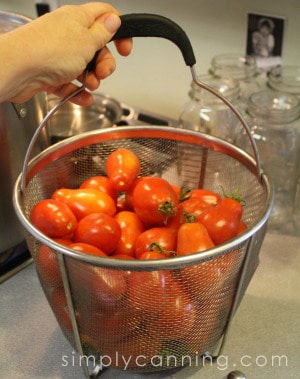
Blanch 4 to 6 (or more if small) tomatoes at a time. This will always depend on the size of the tomato. In the example pictures, I am doing Roma tomatoes. I like them for canning because they are meatier than other tomatoes. They are smaller too, so I can fit more in the blancher.
- Wash tomatoes and dip in boiling water for 30-60 seconds or until skins split. You will often see the skins separating.
- When you remove the tomatoes, drop them immediately into sink or bowl of cold water to stop the cooking.
- Slip off skins and quarter tomatoes. The skins should just slide off in your hands. (Occasionally, I'll use a knife on some stubborn spots.)
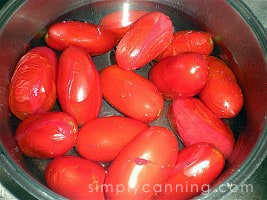
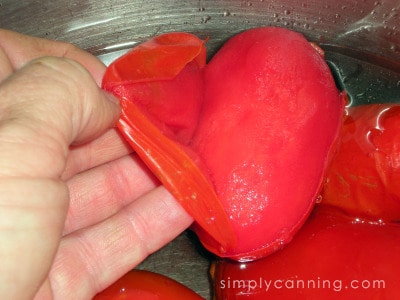
Canning Tomato Sauce Tip
I like to have two pots set up in my double sink. The one on the left is for the cold water to cool the tomatoes as they come out of the blancher. The one on the right is to slide the skins off into. The pots are lower than if you set them on a counter, which is easier on the arms, while the sink makes for easy clean up.
As you skin the tomatoes, slice them into a pot where they will be simmered.
Skinning & Peeling Tomatoes with a Food Mill
Another way of preparing your tomatoes for canning tomato sauce is to use a food mill. This is my preferred method. The food mill removes both the skins and the seeds.
First, wash your tomatoes in cold water, and then slice in half. Simmer the tomatoes to make them softer for the food mill.
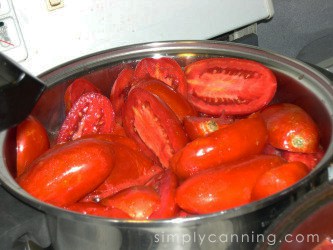
It is easier to do this if you have some juice in your pan to start, so try this: Place a single layer of tomatoes in a pot. As it heats, use a potato masher to crush tomatoes to draw out the juices. When you have a bit of juice in your pot, continue slicing tomatoes in half and adding to the pot.
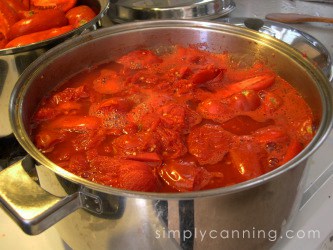
When all tomatoes are sliced, simmer for 15 to 20 minutes or until tomatoes are juicy and heated through.
I used two large pots to simmer 30 pounds of tomatoes. With the tomatoes split into 2 groups, it is less likely to scorch.
Put tomatoes through the food mill. This removes all skin and seeds.
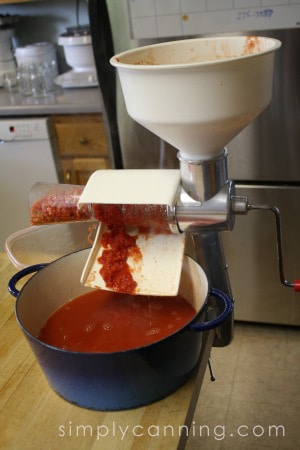
Use a Blender to Liquefy the Tomatoes for Sauce
This canning tomato sauce option does not remove the skins or the seeds. I'll use this on occasion when I'm in a hurry to take care of lots of tomatoes.
Keep in mind that all "official" tested recipes do state to peel the tomato before canning. In my opinion–and I'll repeat that it is my opinion–this is a quality issue. The peels in the jars may be unappealing to some people.
I have a Ball book that I've used for years, and it has the option to use a food processor to make your sauce, and that method would not remove the peels. This book is dated 2009. The recommendation is that you use a current canning book no more than 10 years old. I guess my old friend is now out of date! (It is 2019 as I'm writing this.)
So…
Current recommendations for canning tomato sauce are now to remove those peels completely.
This is an area where you need to make your own decision. I'll give you the information I have, and you get to decide! 🙂
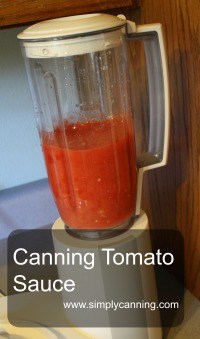
This canning tomato sauce method is pretty self-explanatory. Just wash your tomatoes, remove any stems, plop them in the blender and blend until smooth. Just long enough to get them all soft and saucy. Work in batches a few at a time until all tomatoes are finished.
I do this step with the tomatoes raw. I suppose you could simmer your tomatoes first, but be very cautious about hot liquid spitting out of the blender and burning you.
Canning Tomato Sauce Recipe Instructions
Now you are ready for canning tomato sauce. You can use it in recipes like stewed tomatoes or spaghetti sauce if you want. Canning tomato sauce unseasoned is a great idea. It is very easy to use for many recipes when you are ready to cook supper.
Try this time-saving canning tomato sauce tip. Another reason I love the food mill method.

First, bring the tomatoes to a boil. Use a medium heat, stirring often to prevent burning. If you had especially meaty tomatoes and your sauce is thick, you may need to just stand there and stir.
It can be canned just as soon as it is hot and bubbly. IF you would like to have a thicker sauce, you can cook it down. Simmer, uncovered, to thicken. Cook until it reaches your desired consistency. Stir frequently to avoid burning! The amount of canned tomato sauce may be reduced by nearly one-half.
An easy way to do this is to place sauce in a slow cooker and leave the lid off. Let it cook until thickened.
Gather your canning supplies for canning tomato sauce:
- pressure canner
- canning jars
- canning lids and rings
- jar lifter and canning funnel
- blancher
- bowls
- large spoons
- sharp knife
- towels, dish cloths and pot holders
- food mill or strainer (optional)
Ingredients:
- 30 pounds tomatoes
- Bottled lemon juice
- Salt (if desired)
Do You Have to Add Lemon Juice When Canning Tomatoes?
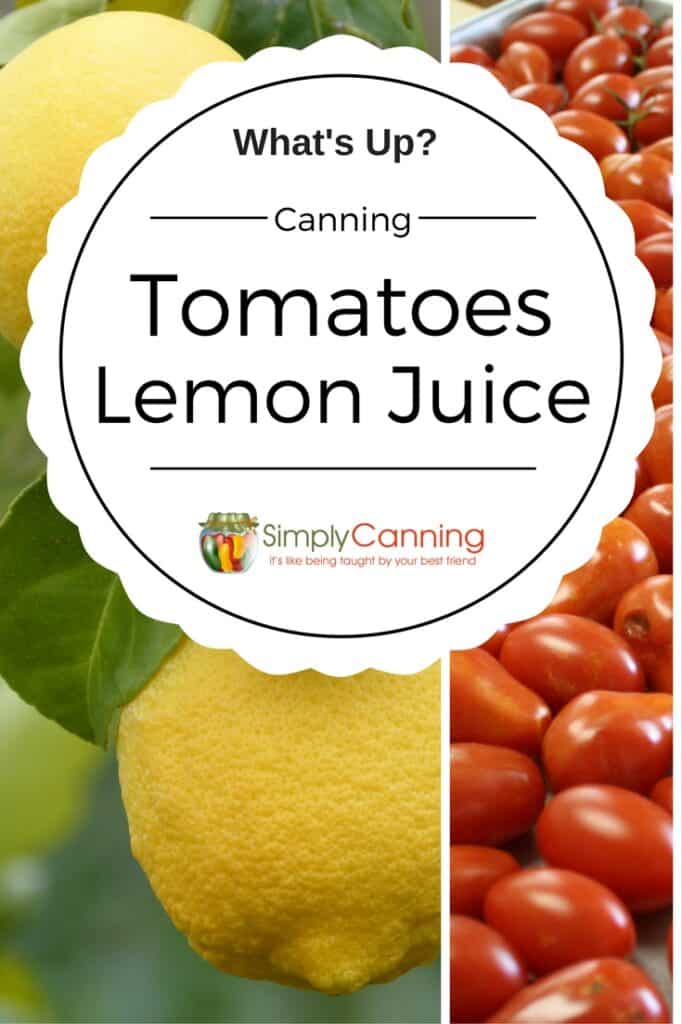
For more information on why acidifying your tomatoes is important, please read: Canning Tomatoes Safely
Do you really need lemon juice?
To process the sauce just as is: Fill hot jars. Add 1 Tbsp. lemon juice to pint jars and 2 Tbsp. lemon juice to quart jars. Leave 1-inch headspace.
My suggestions is to follow pressure canning instructions. This is my preferred method and is what I've included below.
Be sure and adjust your processing to your altitude.
Processing Time
Be sure you are using the correct time with the correct method. Double check…water bath? Or pressure canning? And be sure to use the instructions for your altitude.
For more information on why this is important, see this altitude adjustments page.
Pressure Canning Tomato Sauce
Process pints and quarts for 15 minutes, adjusting for altitude using chart below.
Water Bath Canning Tomato Sauce
Process pints for 35 minutes, adjusting for altitude using chart below.
Process quarts for 40 minutes, adjusting for altitude using chart below.
Recipe Card
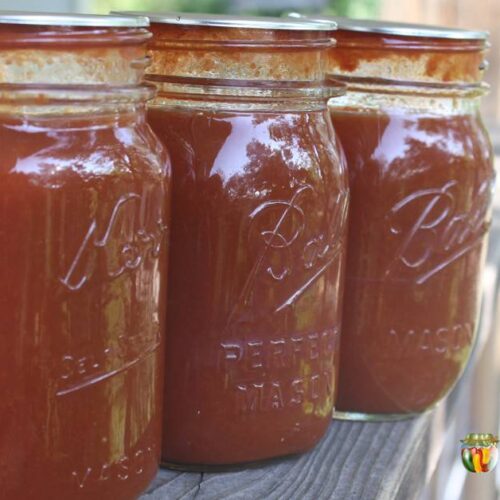
Making & Canning Tomato Sauce
Making & Canning Tomato Sauce
Course Side Dish
Cuisine American
- Tomatoes
- Bottled lemon juice
- Canning salt (if desired)
Procedure for Blanching Tomatoes (Removes Skins)
-
Wash tomatoes.
-
Remove stems and bruises.
-
Remove the skins by blanching tomatoes.
-
Add tomatoes to large stockpot and bring to a boil.
-
Simmer (uncovered) until thickened, stirring frequently.
Procedure for Food Mill (Removes Skins & Seeds)
-
Wash tomatoes.
-
Remove stems and bruises, slicing tomatoes in half.
-
Simmer tomatoes to soften. Use a potato masher to crush the tomatoes to start juices flowing.
-
Cool slightly and run tomatoes through a food mill to remove all skins and seeds.
-
Simmer (uncovered) until thickened, stirring frequently.
-
Now your sauce is ready for use. If you want to can the sauce just as it is, proceed using the directions below. You can also stop here and use the sauce in specific recipes, like spaghetti sauce.
Procedure for Canning Tomato Sauce
-
Start by preparing jars and getting water in the canner heating. You want the canner hot, but not boiling, when the jars are ready to be processed.
If you are new to using a pressure canner, see this article for full pressure canning instructions. This includes more detailed information and step-by-step instructions on how a pressure canner works.
See full water bath canning instructions here.
Hot Pack only
-
Add lemon juice to jar (1 Tbsp. per pint or 2 Tbsp. per quart).
-
Add 1 tsp. salt per quart or 1/2 tsp. per pint (optional, but recommended).
-
Fill hot jar, leaving 1" headspace.
-
Remove air bubbles. Wipe the rim clean and place seal and ring. Place jar in the warm canner. Proceed to fill all jars. Process according to directions below.
Processing Instructions for Water Bath Canner
Processing with a Water Bath Canner
Place the jar in the warm canner. Proceed to fill all jars placing them in the canner.
When all the jars are filled, bring the water in the canner to a boil. When a boil is reached that is when you'll start your timing. Process for the length of time on the chart below. Adjust for your altitude.
After your time is over, turn the heat off remove the lid and allow the canner to rest for about 5 minutes. Then bring your jars up out of the water. Allow them to rest for another 5 minutes. Then remove the jars and place them a few inches apart on a thick towel to cool completely. Leave them alone for about 12 hours.
When they are cooled remove the metal bands, check the seals, label the jars and store them away!
Processing with a Pressure Canner
Place the jars in the warm canner. Proceed to fill all jars placing them in the prepared hot canner.
Put the lid on the canner leaving the weights off. Bring to a boil. Watch for the steam to start coming out the vent pipe in the lid.
Allow the steam to 'vent' for 10 minutes then put the weights on. Use the proper weight for your altitude (check the chart below) This is when pressure will start to build.
When the pressure reaches the pressure required for your altitude (check the chart below) that is when you'll start your time. Process for the full time indicated, adjusting the heat as needed to maintain the correct pressure for the entire time.
When processing time is completed turn off the heat. Do not remove weights yet. Let the canner sit undisturbed until pressure comes back to zero. Do not try to speed up the cooling process.
Remove the weight and wait 5 minutes.
Open the lid to allow steam to escape. (carefully don't let it hit your face or arms!) Leave the lid setting on top of the canner slightly ajar and wait 5 minutes.
Take the lid off the canner and remove your jars. (optionally you can wait another 5 minutes if the contents appear to be bubbling so hard it is coming out of the jars)
Put the jars a few inches apart on a thick towel and allow them to cool to room temperature undisturbed. 12 hours is suggested.
When the jars are cool, remove the metal bands, check the seals, and store the jars in a cool dark place.
Processing Times for Water Bath Canner (Hot Pack)
Altitude – Pints – Quarts
0-1,000 ft – 35 minutes – 40 minutes
1,001-3,000 ft – 40 minutes – 45 minutes
3,001-6,000 ft – 45 minutes – 50 minutes
Above 6,000 ft – 50 minutes – 55 minutes
Processing Instructions for Pressure Canner
Processing Times for Pressure Canner (Hot Pack)
Process pints and quarts for 15 minutes, adjusting for altitude.
Adjustments for Pressure Canner
Altitude – Weighted Gauge
0-1,000 ft – 10 pounds
1,001-8,000 ft – 15 pounds
Altitude – Dial Gauge
0-2,000 ft – 11 pounds
2,001-4,000 ft – 12 pounds
4,001-6,000 ft – 13 pounds
6,001-8,000 ft – 14 pounds
Adapted from: The National Center for Home Food Preservation
Last Updated: 5/7/2021
Keyword canning tomato sauce, Home Canning, Pressure Canning
Comments, Tips, & FAQs
Canning Tomato Sauce Without a Canner: Is It Safe?
By Frank (California)

A few times a year I'll cook a 45 qt pot of tomato sauce just for canning. I use all quart jars. I cook the sauce for hours and make sure the temp is well over 200 degrees.
I wash all my quart jars and run them through my dishwasher on a very hot cycle right before I am going to fill them with the hot sauce. I add a little salt and lemon juice to each jar before filling. I usually try to remove some air bubbles before putting the lids and caps on.
My question is, am I suppose to do a boiling water bath next? I never have and my sauces have lasted over a year with no problems. Maybe three or four out of about 50 quarts will have some mold when I take the lid off but that's probably because a lid didn't sit right.
The sauce is all for personal consumption. I just wonder if the boiling all the cans is a waste of time and not necessary for every type of canning. Seems redundant to boil the jars if the hot liquid I'm putting in them is already piping hot.
What are your thoughts?
Thx. Frank
Sharon's Answer:
Hi Frank,
This is a tough question, because if you've been doing it this way with no problems, you may say "what's the big fuss?" However, I have to still recommend processing your tomato sauce.
When you process the jars after they are filled and the lids placed, the jars and foods are sterilized. All spoiling factors are stopped and the jar is sealed so the food will not be recontaminated.
The concern with not processing your tomato sauce:
- Your jars are very clean…but very clean is not sterilized.
- You stated that you are sure to get your tomatoes to above 200 degrees. Botulism can only be killed at temperatures above 240 degrees.
- Even if you believe your tomatoes have been sterilized by the cooking you have done, it is still exposed to the air and cooking utensils used to transfer it to your jars. It can be recontaminated in that short time.
So now you have food that is in the jars and sealed, but if the bacteria got into your food before it sealed, you have a problem. And as you indicated you have seen mold on a few, so you know that at least those few have been recontaminated even as careful as you can be.
Botulism is the main concern. Mold you can see and simply throw away. However, botulism can not be seen, or tasted, or smelled. You will not know it is there until you get sick. And it can be lethal.
IMHO, you really should be processing in a water bath canner or a pressure canner.
I am glad to see you adding lemon juice, as that acidifies your tomatoes, which also deters botulism. Here is another page about canning tomatoes and acidity levels.
I hope that this helps you make your decision.
Sharon
Frank's Reply:
Sharon, Thanks for the quick reply. Well, everything you pointed out makes very clear sense to me. I did boil my jars, lids and caps prior to canning. Also cooked my sauce to about 210 degrees.
But here is my question now. Is it too late to do the processing bath tomorrow on the jars that I've already canned? They would have sat overnight and cooled and I can hear all the lids popping, which means they are sealing tight.
Do you see any problems with me doing the water bath the day after the canning? In the future I will do it as soon as I'm done canning and while the contents in the jars are hot.
Thanks,
Frank
Sharon's Answer:
Hi again Frank,
Yes, processing tomorrow is fine. As long as it is within 24 hours, you will be okay. You'll need to reheat the contents as you don't want your jars to go into the canner cool. So unfortunately, that means emptying the jars, heating the sauce, and re-jarring with new lids.
Have a great evening.
Sharon
Frank's Reply:
Hi Sharon,
Thanks again for setting me straight on the proper method for processing my cooked tomato sauce. Moving forward I will always remember to process in the hot water bath to ensure killing any potential bacteria.
But this batch is staying the way it is. The thought of emptying out all the jars, re heating, new lids, etc. is a huge hassle and throwing out a days' worth of work is not an option.
Like I mentioned earlier I've probably canned sauce like this at least three times in the past and have had decent luck. I guess I'll take my chances but in the future I'll always do a final water bath. Not sure if it helps at all, but I will be reheating the canned contents to a very high heat prior to eating it.
Thanks for all your input; it was very helpful. I'm going to check out your website and get some other canning ideas.
I also do homemade grape jelly that is incredible.
Thank you, Frank
Sharon's Answer:
Frank, I am so glad I could help. And I don't blame you for not wanting to redo all that work OR throw it away.
I've seen it recommended to boil the food for 10 minutes just prior to eating, as an extra safety precaution. I'd recommend you do that with your tomatoes.
And you know what? I am jelly challenged. LOL. I usually opt for easier jams. In fact, I tried grape jelly for the first time this year and it did not set up. I'm going to try to reprocess it with more pectin. We'll see how it goes. If not, we have some grape syrup. And I did get some grape jam made.
Can I Refrigerate Tomato Sauce & Can It Tomorrow?
By: Anonymous
Not sure if we can get additional answers this way, but I stumbled on this page while wondering if I can can tomato sauce over 2 days? I make sauce much like Frank, but today I started late, and I need to simmer the sauce down for another few hours, and it's already 10pm – is it okay to refrigerate the sauce the way it is now, and then to finish it tomorrow evening? I saw your note about 24 hours, but wanted more detail – is that hard and fast? Is 36 or 48 ok, as long as the half-made sauce is refrigerated?
Thanks!
Jennifer
Sharon's Answer:
Hi Jennifer,
Yes, absolutely. You can refrigerate the sauce as it is and then can it tomorrow or even the next day as you have time.
You need to reheat the sauce, then jar it and process as usual.
This is assuming you have not already filled your jars. You would not want to try to refrigerate your jars and then process them cold tomorrow. 🙂
Why Didn't My Jar of Tomatoes Seal?
By: Diana
I canned tomatoes and corn yesterday. It was late and after I canned the pints of corn I went to bed without hearing them all ping. When I checked today, I noticed they all sealed except for one. Seeing as they sat all night and this am the one not sealed, is it safe to redo the one jar?
Also, I did put water in the jars before processing but notice it seems to only have the water part way up the jar. Is this ok?
Sharon's Answer:
As long as you notice the unsealed jar within 24 hours, it is okay to reprocess. Use the same proper procedures you used the first time.
Yes, sometimes the liquid gets pushed out of the jars. As long as you know you processed for long enough and at the right pressure, it is fine.
Why Do Canned Tomatoes Have Bubbles in Them?
By: Anonymous
When I jarred my tomatoes and took them out of the water bath, I see they have a lot of air bubbles. Is that ok?
Sharon's Answer:
Yes, the air bubbles won't hurt. Be sure you canned them with the correct processing methods. Read more about canning tomatoes here.
Can I Reprocess Tomato Sauce?
By: Jan
Hello, today is Wednesday. I canned 5 bushels of Romanel and San marzan tomatoes on Sunday. (blanched, processed the seeds & skins), boiled down to a thick sauce 50ish minutes and sealed in sterilized Mason jars. Those that did not seal, I refrigerated the next day. Knowing that it has been Sunday to Wednesday, is it too late to re-process the sauce and re-load new jars?
Sharon's Answer:
Well, this answer is too late for your situation, but yes, as long as the sauce was refrigerated, I'd go ahead and reprocess using proper procedures for canning tomato sauce.
Can You Process a Half-Filled Jar of Tomato Sauce?
By: Deb
I have been canning sauce in quart jars for a very long time. Now with an empty nest, I only need pints. My problem is I have tons of quart jars and only a few pints. My question is, can I process half-filled quart jars of sauce?
Sharon's Answer:
No, you need the headspace to be correct in the jars, so half-filled jars would not work.
Botulism Risk in Tomato Sauce
Bby: Fhum
Hello, I read your answer regarding Botulism and how we should use a canner to process tomato sauce.
Last year I followed my husband and his grandfather's lead and they neither added lemon nor processed with a canner. I hadn't done my research last year – now I add 2 tablespoons of lemon juice to a litre of sauce therefore the pH enters the safe zone preventing the spore – found in soil – to produce the bacteria.
This said, how would contaminates from air or utensils change this? From my understanding the spores may be present and boiling does not kill them – but changing the pH prevents this from producing bacteria. Did you mean that the contamination with air and utensils provide problems other than botulism?
Also, would heating the sauce to 185F for 5min before consumption kill the botulism if ever the spores were to produce bacteria?
Thank you so much,
Signed-my husband is Italian and thinks its overkill since his family has been doing this for generations-and I'm a concerned doctor.
Sharon's Answer:
You really need to use tested methods for canning. Adding lemon juice if you are using a water bath is what is recommended. Don't rely on the boiling after the fact.
As far as the debate with your husband…no advice here. 🙂 Just wishes for good luck.
How Long Does Home Canned Tomato Sauce Keep?
Home-canned tomato sauce keeps at least 12 months in optimal storage conditions, but again, that's just a quality issue. Canned food doesn't automatically spoil when 12 months hits! However, quality begins to degrade at that point, so make a point to use it up sooner, that's all.
Why Did My Tomato Sauce Turn Out So Thin?
Thickness of tomato sauce depends on what kind of tomatoes you used. Meatier tomatoes like Romas are most commonly used for sauce. You can use other tomatoes too, but know they'll be juicer and thus will require more cooking to make a thick sauce.
Freezing Canned Tomato Sauce
Yes, if you open a jar of tomato sauce and aren't going to use it all in a timely fashion, you can certainly freeze leftovers for later. But usually, I'll use most of the jar at once! (That's why it's important to decide beforehand whether you'll use pint or quart jars, depending on how much you'll use at once.)
Related Pages
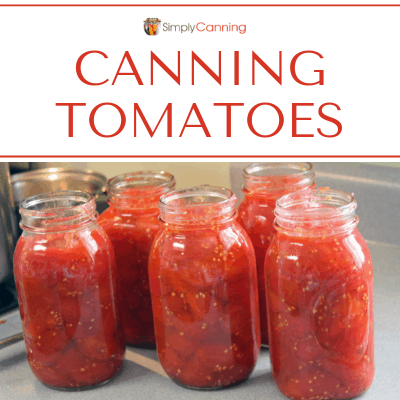
Tips for Home Canning Tomatoes
It's tomato season, and you've got a counter full of tomatoes beckoning you. Before you start canning, here are 3 things you should know about home canning tomatoes.
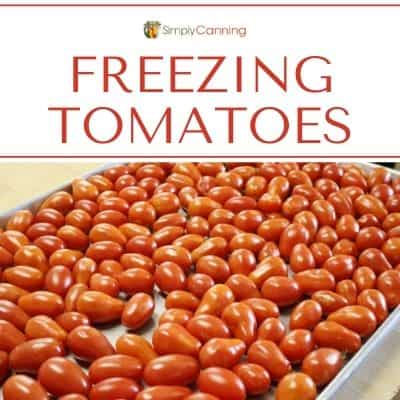
Freezing Tomatoes
Freezing tomatoes can be as straightforward or as complicated as you want it to be. With or without skin, cut or whole, SimplyCanning.com covers it all with a 'how to' video included.
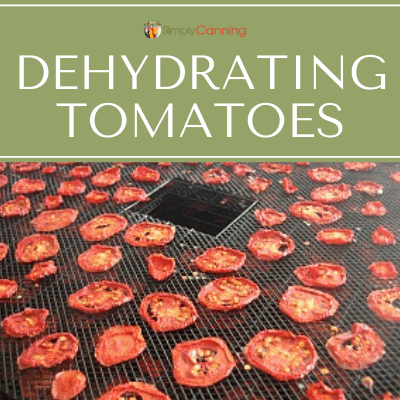
Pin This for Later:
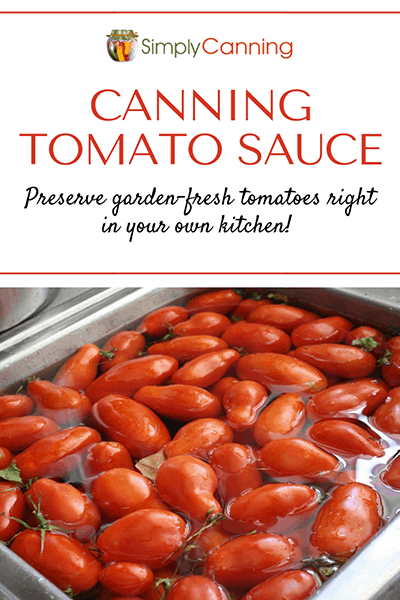
Source: The National Center for Home Food Preservation
Page Last Updated: 6/24/2021
How To Make Homemade Tomato Holders For The Garden
Source: https://www.simplycanning.com/canning-tomato-sauce/
Posted by: taylorsockle.blogspot.com

0 Response to "How To Make Homemade Tomato Holders For The Garden"
Post a Comment